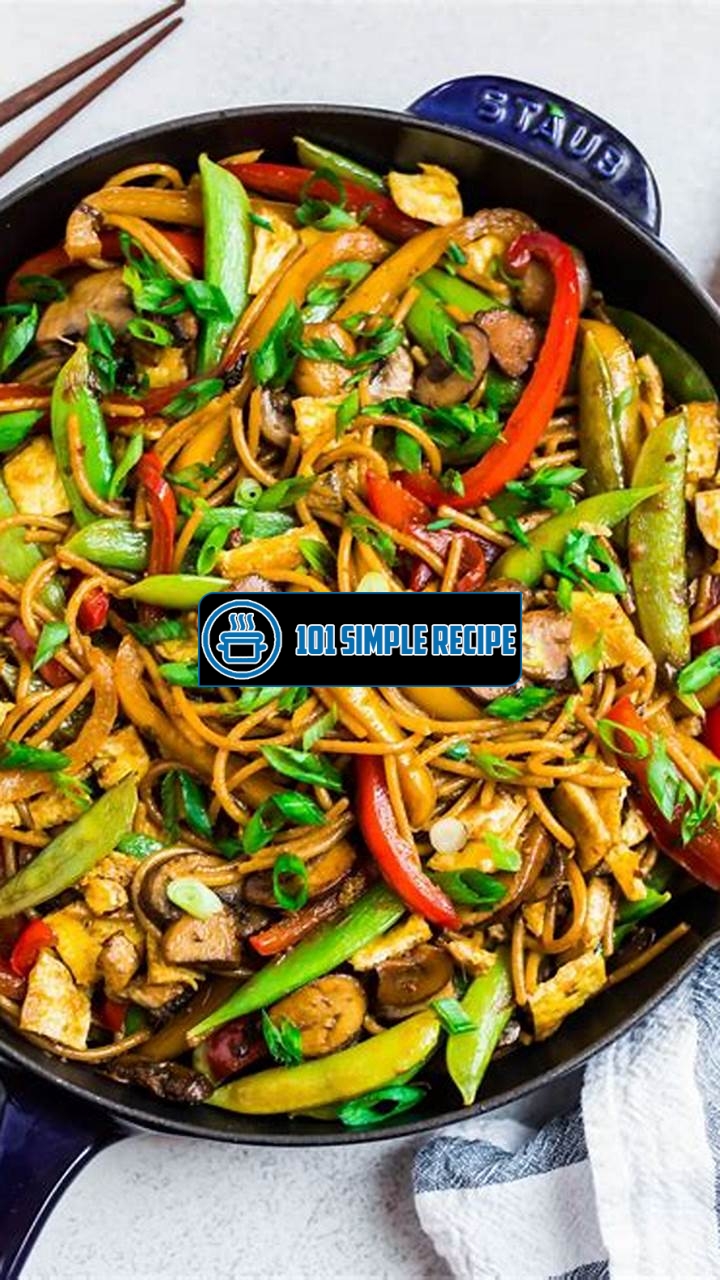Are you a fan of Chinese cuisine? Have you ever wondered whether the popular dish, Lo Mein, is a healthy option? Well, get ready to uncover the surprising truth! In this article, we will delve into the nutritional aspects of Lo Mein and its impact on your well-being. So, sit back, relax, and join us on this journey of exploration to find out if your favorite comfort food can still be a part of a balanced diet.

Understanding Lo Mein and its Healthiness
Lo mein is a tasty and popular Chinese dish that is commonly found in Chinese restaurants around the world. It is a stir-fried noodle dish that consists of wheat noodles, mixed vegetables, and sometimes meat or seafood. The dish is typically flavored with soy sauce, garlic, ginger, and other seasonings to enhance its taste.
When it comes to determining the healthiness of lo mein, it is important to consider its ingredients and nutritional profile. Understanding the components of the dish can help you make an informed decision about whether it can be a healthy meal option for you.
What is Lo Mein?
Lo mein is a type of Chinese noodle dish that is made by stir-frying wheat noodles with a variety of ingredients. The noodles used in lo mein are typically egg noodles or wheat flour noodles, which give the dish a chewy texture and a distinct taste.
The dish is often prepared by first boiling the noodles until they are cooked, then they are quickly stir-fried with vegetables, protein such as chicken, beef, pork, shrimp, or tofu, and a sauce made from soy sauce, oyster sauce, or hoisin sauce. The stir-frying process ensures that the flavors are well-distributed and the ingredients are cooked evenly.
Nutritional Profile of Lo Mein
The nutritional content of lo mein can vary depending on the specific ingredients used and the portion size. However, generally speaking, lo mein can provide a decent amount of carbohydrates, protein, and fiber.
The wheat noodles used in lo mein are a good source of carbohydrates, which are essential for providing energy to the body. They also contain fiber, which aids in digestion and helps to keep you feeling full for longer periods of time. The vegetables added to the dish contribute essential vitamins, minerals, and dietary fiber.
Protein is another important component of lo mein. If you choose to add meat or seafood to your lo mein, it can increase the protein content of the dish. Protein is essential for building and repairing tissues in the body.
Health Factors to Consider
While lo mein can offer some nutritional benefits, there are also factors to consider when determining its overall healthiness. One important consideration is the amount of sodium in the dish. Some lo mein recipes and commercially-prepared versions may contain high levels of sodium due to the use of soy sauce and other seasonings.
Additionally, the overall calorie content of the dish can vary depending on the portion size and the specific ingredients used. If you are watching your calorie intake, it is important to be mindful of the portion size and choose ingredients that are lower in calories.
Another health factor to consider is the cooking method used. Stir-frying can be a healthy cooking method when done with minimal oil and plenty of vegetables. However, if excessive oil or unhealthy fats are used in the cooking process, it can add unnecessary calories and unhealthy fats to the dish.
In conclusion, while lo mein can be a delicious and satisfying meal option, its healthiness depends on various factors such as the ingredients used, portion size, and cooking method. By being mindful of these factors and making healthier choices, you can enjoy lo mein as part of a balanced diet.
Key Ingredients in Lo Mein
When it comes to the popular Chinese dish of lo mein, the key ingredients play a crucial role in determining its overall healthiness. By exploring the essential components that make up a lo mein dish, including the type of noodles used, the choice of protein, and the inclusion of vegetables, you can gain a better understanding of how these ingredients impact the dish’s nutritional value.
Type of Noodles Used
The type of noodles used in lo mein can significantly affect its healthiness. Traditional lo mein noodles are made of wheat flour, giving them a soft and chewy texture. However, for a healthier alternative, you can opt for whole wheat noodles or even zucchini noodles (zoodles). Whole wheat noodles retain the fiber-rich bran and germ, making them a better choice for those seeking a higher nutritional value. Zucchini noodles, on the other hand, are low in calories and carbohydrates, making them an excellent option for individuals following a low-carb or gluten-free diet.
⭐️ Important Point: Choosing whole wheat noodles or zucchini noodles can increase the nutritional value of your lo mein dish.
Choice of Protein
The choice of protein in your lo mein dish also plays a significant role in its overall healthiness. While traditional lo mein often includes proteins like chicken, beef, or shrimp, you can make healthier choices by opting for leaner protein sources. Skinless chicken breast, lean beef cuts, or tofu can be excellent alternatives that are lower in saturated fats and calories. These protein choices provide essential amino acids while reducing the intake of harmful fats.
⭐️ Important Point: Opting for leaner protein sources like skinless chicken breast, lean beef cuts, or tofu can make your lo mein dish healthier.
Inclusion of Vegetables
The inclusion of vegetables is a vital component of any healthy lo mein dish. Vegetables not only add color and flavor but also provide essential nutrients and fiber. Opt for a variety of colorful vegetables, such as bell peppers, broccoli, carrots, and snap peas, to enhance the nutritional content of your dish. These vegetables are rich in vitamins, minerals, and antioxidants, contributing to a well-rounded and nutritious meal.
⭐️ Important Point: Including a variety of colorful vegetables like bell peppers, broccoli, carrots, and snap peas adds essential nutrients and fiber to your lo mein dish.
In conclusion, lo mein can be a healthy and satisfying dish when prepared with the right ingredients. By choosing whole wheat noodles or zucchini noodles, opting for leaner protein sources, and including a generous amount of vegetables, you can enjoy a nutritious and flavorful lo mein meal. Experiment with different ingredient combinations and cooking techniques to create a personalized and healthy version of this beloved Chinese dish.
To add some spice to your lo mein, try this peanut chutney recipe that combines roasted peanuts, garlic, and chili peppers for a flavorful sauce.
Healthy Modifications to Lo Mein
When it comes to enjoying a delicious plate of lo mein, you may be wondering if there are any healthy options available. The good news is that with a few simple ingredient swaps or additions, you can easily create a healthier version of this classic Chinese dish. By making these modifications, you can still indulge in the flavors you love while keeping your health in mind. Here are some tips and tricks to make your lo mein healthier:
Whole Wheat or Alternative Noodles
One way to boost the nutritional value of your lo mein is by using whole wheat noodles or exploring alternative options. Whole wheat noodles are higher in fiber, which can help you feel fuller for longer and support digestive health. They also have a lower glycemic index compared to traditional refined noodles, meaning they won’t cause a sharp spike in your blood sugar levels. If you’re looking to explore alternatives, you can try using zucchini noodles or spaghetti squash as a base. These vegetable-based noodles offer fewer calories and carbs while providing additional vitamins and minerals.
Tip: Opt for whole wheat noodles or experiment with vegetable-based alternatives to increase the nutritional value of your lo mein!
Lean Protein Options
Protein is an essential component of any healthy meal, and lo mein is no exception. Instead of using fatty meats like pork or beef, consider incorporating lean protein options such as chicken breast, shrimp, or tofu. Chicken breast is low in saturated fat and calories, making it a great choice for those aiming to maintain or lose weight. Shrimp is also a good option as it is low in calories and high in omega-3 fatty acids, which are beneficial for heart health. Tofu, on the other hand, is a fantastic plant-based protein alternative that is rich in nutrients and low in saturated fat.
Tip: Swap out fatty meats for lean proteins like chicken breast, shrimp, or tofu to reduce saturated fat and increase the healthiness of your lo mein!
Increase Vegetable Content
One of the easiest ways to make your lo mein healthier is by increasing the vegetable content. Vegetables are packed with essential vitamins, minerals, and fiber, making them a crucial component of a nutritious diet. Some ideal vegetables to include in your lo mein are broccoli, bell peppers, carrots, and mushrooms. These veggies add vibrant colors, interesting textures, and a dose of extra nutrition to your dish. You can also experiment with other vegetables depending on your preferences and seasonal availability. The more colorful and diverse your vegetable selection, the better!
Tip: Load up on veggies like broccoli, bell peppers, carrots, and mushrooms to boost the nutritional value of your lo mein and add a colorful twist to your plate!
Remember, making healthy modifications to your lo mein doesn’t mean compromising on taste. In fact, these simple swaps and additions can enhance the flavors and make your meal even more enjoyable. So, the next time you’re craving a plate of lo mein, don’t hesitate to try out these healthier alternatives!
Cooking Techniques for Healthier Lo Mein
When it comes to enjoying a delicious plate of lo mein, many wonder if it can fit into a healthy diet. The good news is that with a few simple cooking techniques, you can create a healthier version of this popular dish without sacrificing flavor. In this article, we will explore different methods of preparing lo mein that can help reduce the calorie and fat content, allowing you to indulge guilt-free. So, let’s dive in!
Stir-Frying vs. Deep-Frying
One of the first decisions you’ll face when preparing lo mein is whether to stir-fry or deep-fry the ingredients. While deep-frying may result in a crispy and flavorful dish, it also adds unnecessary calories and fat. On the other hand, stir-frying involves cooking the ingredients quickly over high heat, using a minimal amount of oil.
Tip: Opt for stir-frying instead of deep-frying to reduce calorie and fat intake.
By choosing to stir-fry your lo mein, you can cut down significantly on the amount of oil used and still achieve great taste and texture. The high heat of stir-frying allows the ingredients to cook evenly and retain their natural flavors, while the minimal oil prevents unnecessary greasiness.
Reducing Oil Usage
While stir-frying is a healthier cooking method, it is essential to watch the amount of oil you use during the process. The goal is to add just enough oil to prevent the ingredients from sticking to the pan while avoiding excessive greasiness. Here are a few tips to help reduce oil usage:
- Use a non-stick pan or wok to minimize the need for oil.
- Use cooking sprays or broth instead of oil to sauté vegetables and proteins.
- Measure the amount of oil you use to ensure you are not pouring more than necessary.
Tip: Minimize oil usage by utilizing non-stick pans, cooking sprays, and measuring the oil precisely.
Following these oil-reducing tips can help decrease the calorie and fat content of your lo mein while still retaining its delicious taste.
Controlling Sodium Levels
In addition to reducing oil, controlling the sodium levels in your lo mein can contribute to a healthier dish. Many store-bought or restaurant versions of lo mein can be loaded with sodium, which can negatively impact your health if consumed in excess. Here are some strategies to control sodium levels:
- Use reduced-sodium soy sauce or tamari instead of regular soy sauce.
- Limit the use of additional salt and try using herbs and spices to enhance flavor.
- Include plenty of fresh vegetables to add natural sweetness to the dish.
Tip: Opt for reduced-sodium soy sauce, minimize additional salt, and incorporate fresh vegetables to control sodium levels.
By following these tips, you can enjoy a healthier version of lo mein that is lower in sodium without compromising on taste.
In conclusion, lo mein can be a part of a healthy diet when prepared using the right cooking techniques. By choosing stir-frying over deep-frying, reducing oil usage, and controlling sodium levels, you can enjoy a flavorful plate of lo mein without worrying about the negative health impacts. So go ahead, whip up a batch of nutritious and delicious lo mein today!
For a healthy alternative to traditional lo mein, try this weight loss recipe that uses whole wheat noodles and plenty of fresh vegetables.
Understanding Portion Control
When it comes to enjoying a plate of delicious lo mein, portion control is key to maintaining a balanced and healthy diet. Lo mein, a popular Chinese dish consisting of stir-fried noodles, vegetables, and sometimes meat or seafood, can be a satisfying and flavorful meal option. However, it’s important to be mindful of the serving size and make conscious choices to ensure you’re getting the right balance of nutrients.
Recommended Serving Size
The recommended serving size for lo mein is typically about 1 cup, which is equivalent to 200 grams. This portion provides a good balance of carbohydrates, protein, and fats to keep you feeling satisfied. It’s important to note, however, that different restaurants and recipes may vary in terms of portion sizes. Be sure to read nutrition labels or ask your server about the serving size to make informed decisions.
️ Remember to stick to the recommended serving size of 1 cup of lo mein to avoid overeating and to maintain a healthy diet.
Balancing Lo Mein with Other Foods
While lo mein can be a delicious and satisfying dish on its own, it’s important to balance it with other foods to ensure you’re getting a well-rounded meal. Adding vegetables, such as broccoli, carrots, or bok choy, can increase the fiber and nutrient content of the dish. Including lean protein sources, like chicken, shrimp, or tofu, can also enhance the nutritional value.
Don’t forget to add a variety of colorful vegetables and lean proteins to your lo mein to make it a more nutritious and balanced meal.
Managing Calories and Nutrients
When enjoying lo mein, it’s important to manage your calorie intake and pay attention to the overall nutritional composition. While lo mein can be a flavorful and satisfying dish, it can also be high in calories and sodium if prepared and consumed excessively.
Avoid adding excessive amounts of oil or sauces, as they can significantly increase the calorie content. Additionally, be cautious of portion sizes and opt for whole wheat or vegetable-based noodles for added fiber and nutrients.
Remember to watch your portion sizes and choose healthier options, such as whole wheat or vegetable-based noodles, to manage your calorie and nutrient intake.
In conclusion, lo mein can be a part of a healthy and balanced diet when consumed in moderation and with mindful choices. By understanding portion control, including recommended serving sizes, balancing lo mein with other foods, and managing calories and nutrients, you can enjoy this delicious dish while maintaining your health and wellness goals.
If you’re looking for more healthy recipes, check out this white castle recipe that features lean ground beef and reduced-fat cheese.
Frequently Asked Questions
Thank you for reading our article on making lo mein healthy. We hope you found it informative and helpful. If you have any further questions, please refer to the frequently asked questions below:
| No. | Questions | Answers |
|---|---|---|
| 1. | Is lo mein healthy? | Yes, lo mein can be a healthy dish if prepared with nutritious ingredients and cooked in a balanced way. By using whole grain noodles, plenty of vegetables, lean protein, and a minimal amount of oil, you can enjoy a healthier version of lo mein that is still delicious. |
| 2. | Can I make lo mein gluten-free? | Yes, you can make lo mein gluten-free by using gluten-free noodles, such as rice noodles or gluten-free spaghetti, and ensuring that all the sauce and ingredients you use are gluten-free. There are also gluten-free soy sauce alternatives available that you can use to maintain the flavor profile. |
| 3. | What are some healthy protein options for lo mein? | Some healthy protein options for lo mein include grilled chicken breast, tofu, shrimp, lean beef, or even edamame. These options provide essential nutrients without excess fat or calories, making your lo mein a well-rounded and satisfying meal. |
| 4. | How can I reduce the sodium content in lo mein? | To reduce the sodium content in lo mein, you can use low-sodium soy sauce or tamari and limit the amount of added salt in the dish. Additionally, incorporating fresh herbs, spices, and citrus flavors can enhance the taste without relying on excessive salt. |
| 5. | Can I make lo mein vegan? | Absolutely! You can make lo mein vegan by using vegetable-based ingredients like tofu or tempeh for protein and substituting the oyster sauce with vegan-friendly alternatives. You can also experiment with different vegetables and sauces to create a flavorful vegan lo mein dish. |
| 6. | Are there any alternatives to traditional lo mein noodles? | Yes, if you’re looking for alternatives to traditional lo mein noodles, you can try using spiralized vegetables like zucchini or butternut squash noodles, or even shirataki noodles made from konjac yam. These alternatives offer a lighter and lower-carb option while still providing a satisfying base for your lo mein. |
Closing Thoughts: Thank You for Reading!
We hope you enjoyed learning about how to make lo mein a healthier and more nutritious dish. By incorporating whole grains, fresh vegetables, lean protein, and mindful cooking techniques, you can indulge in this Chinese classic without sacrificing your health goals. Remember, balance is key, and with these tips, you can create a delicious and wholesome lo mein at home. Thank you for reading, and we look forward to having you visit again for more helpful articles!
Jump to Recipe
Healthy Lo Mein Recipe

Learn how to make a healthier version of the classic lo mein dish with this easy recipe. Packed with nutritious ingredients and full of flavor, this lo mein recipe is a must-try!
- 4 oz whole grain lo mein noodles
- 1 cup thinly sliced vegetables (such as bell peppers, carrots, and broccoli)
- 4 oz lean protein (chicken breast, tofu, or shrimp)
- 2 cloves garlic (minced)
- 1 tablespoon low-sodium soy sauce
- 1 tablespoon oyster sauce
- 1 tablespoon sesame oil
- 1/4 teaspoon red pepper flakes (optional)
- 2 green onions (thinly sliced)
- Bring a pot of water to boil and cook the lo mein noodles according to package instructions. Drain and set aside.
- In a small bowl, whisk together the soy sauce, oyster sauce, sesame oil, and red pepper flakes (if using). Set aside.
- Heat a tablespoon of oil in a large skillet or wok over medium-high heat. Add the minced garlic and cook for 30 seconds until fragrant. Add the protein of your choice and cook until browned and cooked through. Remove from the skillet and set aside.
- In the same skillet, add the sliced vegetables and stir-fry for 2-3 minutes until crisp-tender. Return the cooked protein to the skillet.
- Add the cooked lo mein noodles and the prepared sauce to the skillet. Toss everything together until well coated and heated through.
- Transfer the lo mein to serving plates and garnish with sliced green onions. Enjoy your homemade healthy lo mein!






